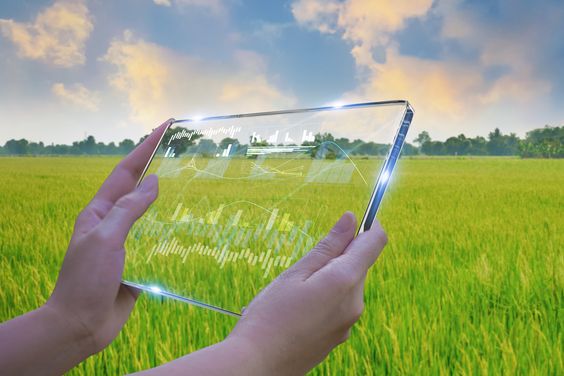Harvesting Efficiency: How Agricultural Data Interoperability Empowers Smart Agriculture
Agricultural Data Interoperability sector stands at a crossroads. The ever-growing global population demands a significant increase in food production, while environmental concerns necessitate a shift towards sustainable practices. Smart Agriculture, with its data-driven approach, offers a compelling solution. At the core of this revolution lies a critical concept: Agricultural Data Interoperability.
Introduction: A Symphony of Agricultural Data Interoperability for a Sustainable Future
Imagine a scenario where tractors seamlessly exchange information about soil conditions, drones share real-time pest detection data with irrigation systems, and weather stations automatically adjust fertilizer application based on upcoming forecasts. This interconnected network of data exchange is the essence of Agricultural Data Interoperability.
In simpler terms, interoperability ensures that agricultural data generated from various sources – sensors, machinery, weather stations, and software applications – can be seamlessly understood and utilized by other systems. This eliminates data silos, fosters collaboration, and unlocks the true potential of Smart Agriculture.
The Pillars of Agricultural Data Interoperability
The foundation of interoperability lies in standardized data formats and communication protocols. Here’s a breakdown of the key elements:
- Standardized Data Formats: Just as countries utilize a common alphabet for communication, agriculture needs a common language for data exchange. Standardized formats like Agricultural Markup Language (AML) and SensorML ensure that data is structured consistently, making it interpretable by different systems.
- Communication Protocols: These protocols define the rules for how data is exchanged between devices and software applications. Protocols like Open Geospatial Consortium (OGC) Sensor Web Enablement (SWE) and Agricultural Data Exchange (ADX) facilitate the secure and reliable transfer of information.
- Metadata: Think of metadata as data about data. It provides context and meaning to the raw information, specifying details like sensor type, measurement units, and timestamps. Rich metadata allows systems to understand the data’s origin, purpose, and limitations.
The Symphony in Action: How Interoperability Benefits Agriculture
By enabling seamless data exchange, Agricultural Data Interoperability unlocks a multitude of benefits for the agricultural sector:
- Precision Agriculture: Imagine tractors applying fertilizer only where needed, or irrigation systems adjusting water usage based on real-time soil moisture data. Interoperability facilitates the collection and analysis of granular field-level data, empowering farmers to make informed decisions for optimized resource utilization and improved yields.
- Enhanced Farm Management: Interoperable data allows farmers to gain a holistic view of their operations. By integrating data from various sources, they can track performance metrics, identify trends, and make data-driven decisions regarding planting schedules, resource allocation, and pest control.
- Improved Sustainability: Data-driven insights can help farmers adopt sustainable practices. Interoperability enables the monitoring of soil health, water usage, and carbon footprint, allowing farmers to fine-tune their operations to minimize environmental impact.
- Streamlined Traceability: Consumers are increasingly interested in the origin and quality of their food. Interoperable data provides a transparent audit trail, allowing farmers to track their produce from farm to fork, fostering trust and brand value.
- Unlocking Innovation Agricultural Data Interoperability: A standardized data ecosystem fosters collaboration and innovation. Researchers, developers, and agribusinesses can leverage interoperable data to develop new tools, technologies, and services that cater to the specific needs of the agricultural sector.
Challenges and Considerations on the Road to Interoperability
While the potential of Agricultural Data Interoperability is undeniable, there are challenges to overcome:
- Standardization Adoption: Widespread adoption of standardized formats and protocols is crucial. Industry stakeholders, governments, and technology providers need to collaborate to ensure consistent implementation.
- Data Security and Privacy: As data becomes the lifeblood of agriculture, robust cybersecurity measures are essential to protect sensitive farm data from breaches and misuse.
- Infrastructure and Connectivity: Interoperability relies on reliable internet connectivity across rural areas. Bridging the digital divide is crucial to ensure equitable access to the benefits of Smart Agriculture.
Conclusion: A Collaborative Effort for a Bountiful Future
Agricultural Data Interoperability is not a technological marvel, but rather a collaborative effort. By working together to overcome challenges and embrace standardized practices, stakeholders across the agricultural value chain can usher in a new era of data-driven farming. This will empower farmers to cultivate a future that is not only productive but also sustainable and resource-efficient, ensuring food security for generations to come.
The journey towards a truly interoperable agricultural data ecosystem has just begun. By fostering collaboration, embracing innovation, and prioritizing standardization, we can transform agricultural data from scattered notes into a powerful symphony that orchestrates a sustainable and abundant future for agriculture.




